A Oneworld multi-carrier award on British Airways Avios is a cost-effective way to sample an abundance of Oneworld airlines on a single itinerary.
Each trip can have at most eight segments, combined with generous stopover and open-jaw policies. Availability in premium cabins is usually decent, if not plentiful. Furthermore, Avios is a transfer partner of American Express and RBC in Canada, making it easy to accumulate a meaningful balance of points within a few months.
As flexible as a multi-carrier trip looks on paper, British Airways does a great job at not disclosing detailed routing rules. Some people get round-the-world trips with five or six stopovers ticketed, while others get turned away for the slightest irregularity.
I decided to test the waters by calling British Airways and trying to book six itineraries that push boundaries by either backtracking, taking long detours, or maximizing segment and stopover allowances. Here are the results.
Multi-Carrier vs. Standard Avios Awards
The multi-carrier award chart is the only Avios award chart that prices itineraries cumulatively and not segment-by-segment.
To illustrate the difference, consider an extravagant business class trip from Tokyo to Santiago via London and Bogotá.
If I were to fly British Airways and LATAM during the Christmas season, the trip would fall under the regular award charts, costing a total of 203,750 Avios:
- Tokyo (TYO) – London (LON) at 90,000 Avios, peak British Airways award in Zone 7.
- London (LON) – Bogotá (BOG) at 75,000 Avios, peak British Airways award in Zone 6.
- Bogotá (BOG) – Santiago (SCL) at 38,750 Avios, partner award in Zone 4.
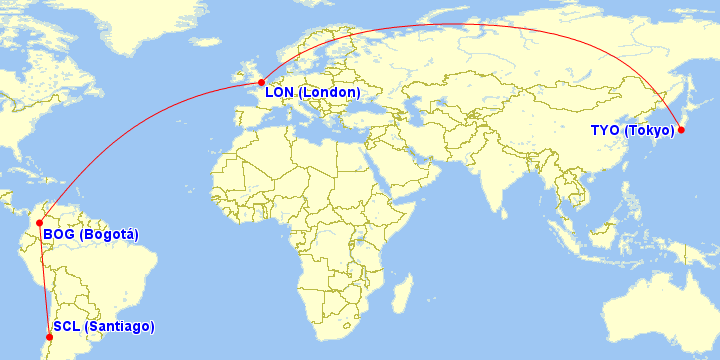
Instead, multi-carrier awards are triggered upon including two separate Oneworld airlines on the same itinerary. To qualify for a multi-carrier award, I could introduce a second partner airline by flying JAL from Tokyo to London, instead of British Airways.
Miles in your journey | Avios required for... | |||
Economy | Premium economy | Business | First | |
0–1,500 | 30,000 | 45,000 | 60,000 | 90,000 |
1,501–4,000 | 35,000 | 52,500 | 70,000 | 105,000 |
4,001–9,000 | 60,000 | 90,000 | 120,000 | 180,000 |
9,001–10,000 | 70,000 | 105,000 | 140,000 | 210,000 |
10,001–14,000 | 90,000 | 135,000 | 180,000 | 270,000 |
14,001–20,000 | 100,000 | 150,000 | 200,000 | 300,000 |
20,001–25,000 | 120,000 | 180,000 | 240,000 | 360,000 |
25,001–35,000 | 140,000 | 210,000 | 280,000 | 420,000 |
35,001–50,000 | 160,000 | 240,000 | 320,000 | 480,000 |
The total distance flown between the four cities is about 13,900 miles, falling just short of the 14,000-mile threshold for the price point of 180,000 Avios in business class. This yields about 23,750 Avios in instant savings.
The more complex a journey is, the more convenient multi-carrier rules are. Booking one-ways with long detours is just one of the ways to gain value. Round-the-world trips with multiple stopovers and a mix of economy, luxury First Class, and business class flights could result in hundreds of thousands of miles in savings.
Booking an Avios Multi-Carrier Award
There are three rules which are set in stone for a multi-carrier award:
- It may contain at most eight flights, including connections.
- If it has an open-jaw, the terminal points must be in the same IATA zone. Hence, looping around the world more than once is not allowed.
- It may not pass through the same city twice, even if only for a layover. As a result, going through a single Oneworld hub such as London or Doha for both the inbound and outbound legs is not allowed. This appears to be a technical limitation on the British Airways side.
You need to hand-pick the segments you plan to fly, confirm availability on the Avios website, and then call British Airways to book.
After entering the itinerary into the system, the agent reserves the seats for you and sends the booking to the “fares” team to calculate the taxes and fees. With certain two-airline combinations, they may calculate the amount on the call and issue the ticket right away.
Partner airlines only allow British Airways to hold seats without issuing a ticket for a limited amount of time. If the backend team takes too long to quote your booking, you may have to request the taxes and fees again, provided availability did not disappear. Due to these delays, multi-carrier awards are not reliable for last-minute trips.
Flights on British Airways metal incur the highest out-of-pocket costs in the form of hefty fuel surcharges. Iberia and Qatar Airways are not far behind. Even if the trip originates in a country with surcharge regulations, such as Japan or Brazil, British Airways seems to be able to reintroduce them if you have stopovers.
For trips that take full advantage of multi-carrier award rules, be ready to pay about $1,000 in taxes and fees (even with segments in economy class).
A Few Test Itineraries
Reasonable Backtracking
Formally, backtracking refers to travelling in the opposite direction of the original flights on a one-way itinerary, such as going from Los Angeles to Tokyo via Hong Kong.
Airlines usually allow backtracking within reasonable bounds to accommodate layovers at hub airports.
However, some recent data points suggested that British Airways may have tightened the rules around such routings. I therefore tested two itineraries, both of which are geographically backtracking without crossing zone boundaries:
- Los Angeles–Hong Kong–Tokyo–Doha, on Cathay Pacific and Qatar Airways
- London–Hong Kong–Kuala Lumpur, on Cathay Pacific and Malaysia Airlines
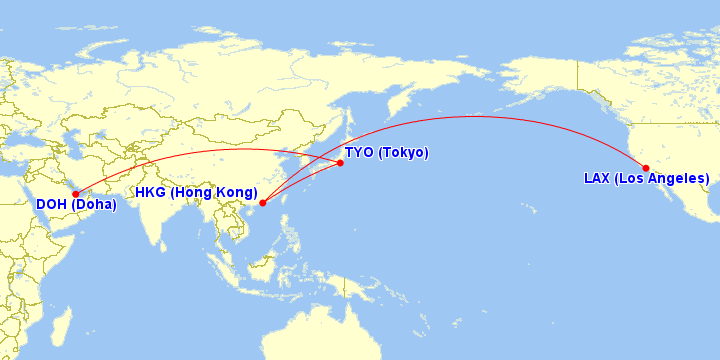
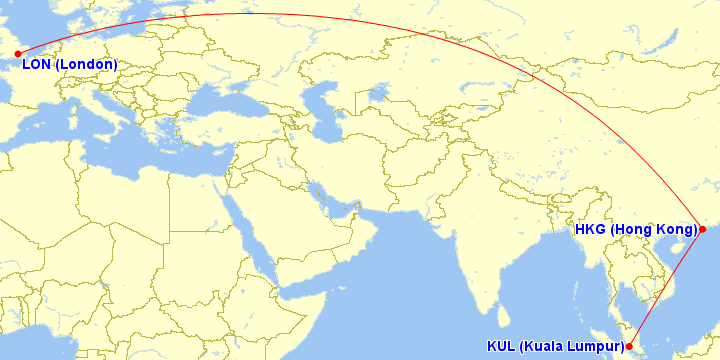
In the first set of flights, connecting from Hong Kong to Japan to catch a flight to Qatar is not entirely unreasonable, and the call centre agents didn’t object. Unfortunately, Cathay Pacific pulled the seats before the fares team could calculate the taxes, so I did not get a quote.
Luckily, the second set of flights priced successfully, at 90,000 Avios and about $600 in fees.
Long Detours
Paragraph 15.13 in the British Airways Executive Club terms and conditions state the following:
Rewards are based on round trip travel between origin and destination using the most direct route possible.
British Airways was never very adamant about enforcing this rule. I decided to see if that has changed.
The first roundabout trip I proposed is Honolulu–Sydney–Tokyo–Doha, with a stopover between each segment. There are no direct flights between Hawaii and Qatar; however, taking a 6,000-mile “connection” in Australia is not the most direct option.
Regardless, British Airways was willing to price out those Qantas and Qatar Airways seats for 100,000 Avios and about $400 in taxes.
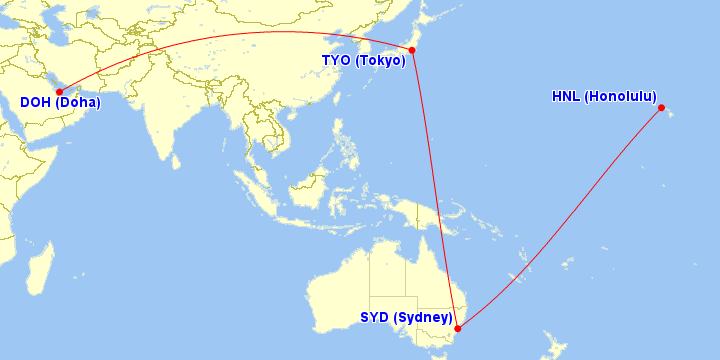
In another test itinerary, I went from Dallas to Moscow, with stops in Seoul and Doha. My choice of flights adds about 7,500 miles to the great circle distance between the terminal points.
A much more “reasonable” way would have been to route through London, but I decided to cross the Pacific instead. Having chosen American Airlines and Qatar Airways for this trip, I received confirmation from the ticketing and fares teams that I’d have to pay 90,000 Avios and $800 in taxes and fees.
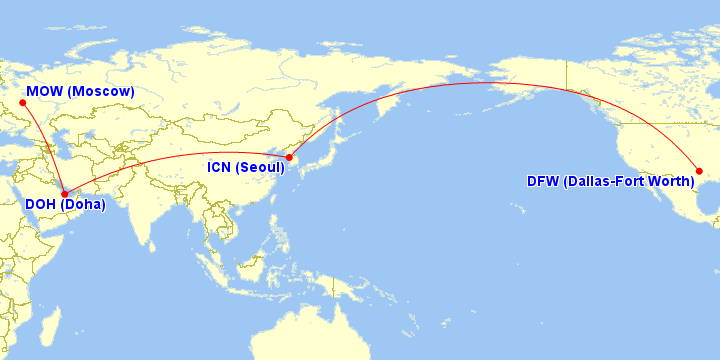
Round-the-World
When asked about round-the-world trips, British Airways agents confirmed that round-the-world trips are allowed, as long as they follow a “return standard”: a passenger must depart from and arrive in the same IATA zone, like any other round-trip flight.
My moderately ambitious undertaking follows a Tokyo–Doha–Madrid–Boston routing on the outbound journey. I then requested an open-jaw within the US and depart back to Japan on a direct flight from Chicago.
Flying on Qatar Airways and American Airlines, this ticket was priced out successfully at 100,000 Avios and $500 in taxes and fees.

A (More) Ambitious Undertaking
I went all out on the sixth and final test itinerary, which takes me from Japan to Argentina. Tokyo–Hong Kong–Kuala Lumpur–Doha–Moscow–London–New York–Buenos Aires: six stopovers, seven segments, all in business class, with a bit of economy to spice up the calculations.

This routing is technically a one-way bound between Tokyo and Buenos Aires. Unsurprisingly, the fares team refused to ticket it as it’s not a “return standard”. Indeed, it’s an extravagantly roundabout way to go from Zone 3 to Zone 1.
(They offered to remove all segments from Doha onwards and put the rest of the journey on a separate itinerary, which I politely refused.)
The agent did not clearly explain the rules, but I inferred that the only way to maximize the stopover allowance is to have a “return standard.” If you’re trying to book a convoluted one-way bound that doesn’t start and end in the same IATA zones, it may not be possible to include stopovers everywhere, as seen here.
A Real-Life Ambitious Undertaking
Finally, the most ambitious example is one that I had successfully ticketed – but just as successfully cancelled – back in 2020.
This itinerary had eight segments, one open-jaw, and five stopovers: Tokyo, Sapporo, Osaka, Moscow, and London. As you can tell, it respected the “return standard” of starting and ending in the same IATA zone, which is why the five stopovers were allowed.
Being a mixed-cabin redemption, this had cost me 140,000 Avios and about $800 in taxes and fees. It’s a real shame I never got to fly it.
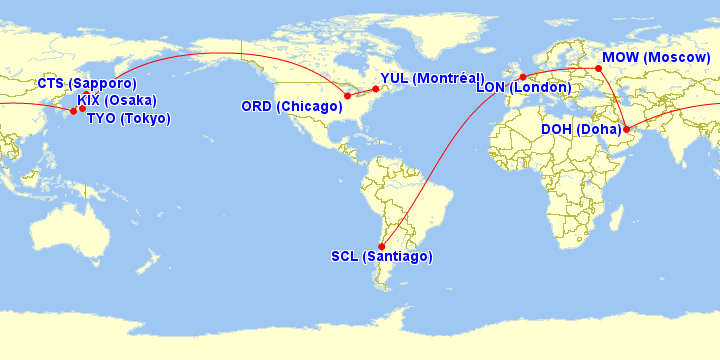
Conclusion
The British Airways Avios multi-carrier award chart is a lucrative opportunity for aspirational travel on award-winning Oneworld airlines, such as Qatar Airways, Cathay Pacific, and Japan Airlines.
Despite heavy taxes and “your mileage may vary” (YMMV) ticketing rules, a savvy Miles & Points enthusiast will find an efficient way to combine the eight allowed segments to derive maximum value.
While the rules are lax on paper, the fares team may deny itineraries that push too many boundaries. Bookings that start and end in the same IATA zone have the best chance of getting ticketed successfully. The more a trip resembles a “reasonable” routing instead of a #YOLO adventure, the easier it is to see it through.
Even with seemingly valid itineraries, there is still an element of YMMV. If a call centre agent comes up with previously unheard-of rules, such as being unable to mix cabins or airlines on a single ticket or otherwise construct a round-the-world routing that you believe is reasonable, you should always hang up and call again.


















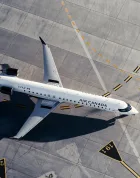
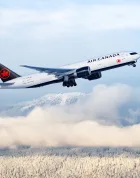

Hi Alex, habe you information about extending an existing booking?
Let’s say I book 10 month in advance from Europe to Australia, however my return/continue flight from Australia would be in 15 month.
Any chance to add segments to an existing ticket, once the flight schedule opens for that upcoming date?
Yes u can make changes, subjected to normal award “change/cancel” fees payable to BA executive club
Booked syd-doh-cdg//hel-lhr-bda-lhr-doh-akl with no issues
Also:
bkk-doh-cdg//dus-lhr-mex-lhr-sin-kul
And
Hkt-doh-fra//dus-lhr-jnb-lhr-kul
Taxes were 850-1,500 (2nd one was most expensive)
Excellent article.. i am accumulating avios for the last 2 years and wanted to maximize the segments, mixed cabins (F/J/Y). this article is good start for me..hope to see some economy legs itineraries as well
Do you think YYC-SEA-DOH-JED-AMM-CAI with stopovers in every city will be allowed or just like
I think it’s a bit of a long shot, but never hurts to try.
Glad to see more relevant articles! I have to admit that the last few weeks had incredibly weak blog articles and it felt a lot like crafted advertisements. I would love to see more articles of this sort
I was successfully able to book GIG-LHR (BA), LHR-DUB (BA), DUB-DOH (QR), DOH-CMB (QR), CMB-BKK (UL), BKK-HND (JAL), NRT-SFO (JAL) and JFK-LHR (BA) all in J last year. Was due to start in April, was heart breaking to have to cancel it.
Interesting. Only shows how YMMV this type of booking is. How many stopovers did you have?
I booked it around January 2020 so perhaps the rules have been tightened now. The actual stopovers were DUB, DOH, CMB, BKK, Toyko and SFO.
Interesting! the GIG-LHR leg would seem to invalidate the “return standard” criteria but you were still able to have it ticketed. Did you have that at the beginning of your journey?
Ya the order above is the actual order, GIG-LHR was the first flight, it did wonders for the taxes and fees.
wow- amazing itinerary- how many avios was that?
I didn’t bother trying to add any economy legs, so it came in at just under 25k miles so it was 240k Avios plus about $950 in taxes and fees. I got lucky though, when I was paying for it 2 of the flights had dropped out of the booking which caused the distance to drop to the 20k / 200k Avios band. She was already after charging me, then added the flights back in and never recalculated the cost.
Good job Dan.. how were you planning to connnect GIG and return.. is your actual origin is North america?
The entire thing was a 4-month trip from March – June that involved stopping in DUB twice to attend weddings. We did get the start the earlier part of the trip in March but never made it to GIG to start the multi-carrier booking. We live in Toronto, we booked a cash fare to MIA and then MIA-MVD on AA J booked via Avios (not a great deal but it was last minute). We had cash fares / ferries / car rental from Uruguay, to Argentina and then to Brazil where we would start the first leg. The plan was to then end up in LHR at the very end in June, cash fare to DUB for the wedding and then back to YYZ with EI booked via Avios.
thx for the info Dan.. well now that the trip is cancelled. are you planning for different itinerary.. I am based from YYZ as well and wanted to maximize the segments and cover South america, Middle east, Asia (tokyo, Philippines). so far accumalated 300k avios for family of three and started reading thru sample itineraries and mix the last leg Y combination.. not able to connect the dots
I’ll have a baby soon enough so I won’t be planning a another trip like that again for some time. I would recommend FlightConnections.com and GCMap.com to help you plan a route. I found the AA wesbite the most useful when searching for availability. Keep in mind as well that unless you start in country that regulates YQ, you’ll get screwed on taxes if you plan on utilising all 8 segments. I originally had an itineary that started in BOG and they quoted me $3k each in taxes, that was why I decided to start in GIG.